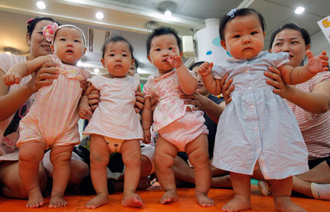We’re in the middle of an awkward transition between a world based on primitive physical primacy and one based on ideals of equality between the sexes.
Women are now the presidents or prime ministers of Argentina, Australia, Brazil, Bangladesh, Costa Rica, Croatia, Finland, Germany, Iceland, India, Ireland, Kyrgyzstan, Liberia, Lithuania, San Marino, Slovenia, Switzerland, Trinidad and Tobago, based on my cursory research.
But in countries like China, India and S. Korea girl babies are killed in embryo by the millions each year. Even sadder are the thousands of girls in India being mutilated in illegal sex-change operations in hopes of turning them into quasi males who can only look forward to a lifetime of suffering in sexual purgatory.
The result is extreme gender imbalances that will leave tens of millions of young Chinese, Indian and S. Korean men without brides. In China — by far the worst offender — 119 boys are born for every 100 girls, with the ratio getting as high as 130 boys in some rural provinces. As a result by the year 2020 24 million Chinese men of marrying age won’t be able to find wives.
In India the number of gender-selective abortions are on the rise. Selective abortions of girls rose from fewer than 2 million in the 1980s, to between 1.2 and 4.1 million in the 1990s, and between 3.1 and 6 million in 2000-2010. As a result, for every 100 girls born today, there are 109 boys. The natural rate would be between 103 and 105 boys for every girl.
The disparity is even more extreme among India’s second-born children. In 1990 there were 110 boys born for every 100 girls among all second-order births. In 2005 the imbalance jumped to 120 boys for every 100 girls among second-order births. This suggests that abortions had become a tool for families trying to ensure at least one son.
This preference for sons is manifest in birth ratios even in S. Korea, an industrialized society with a far smaller percentage of families who rely on sons for physical labor or economic survival. Unlike in India or China, the ratio for first- and second-order births fall within the normal range at 104.9 and 105.6 boys, respectively, for every 100 girls.
But among third- and fourth-order Korean births, the imbalance is far more pronounced though no precise figures are available due to the fact that few are willing to openly participate in studies on gender-selective abortions which are illegal in S. Korea. But the undeniable result is an extreme shortage of marriage-age Korean women. In 2009 there were 1.98 million S. Korean men aged 29 and 33, years deemed prime marriage age for men, about 70,000 more than the 1.91 million women in the prime marriage age of 26-30. The disparity grew to 134,200 in 2010 and is expected to reach a record 381,300 in 2014.
I understand the economic factors behind the son-preference in backward societies where a boy might be able to cultivate more hectares of crops or earn more in backbreaking labor tearing down rusting ships and machinery for scrap iron. I also understand the burden of ancient customs that require the payment of dowries to marry off girls. But even those reasons aren’t good enough, among reasonably balanced human beings, for destroying new lives and violating the natural gender balance.
What is difficult to understand in this day and age is the fanatical preference for sons among families in advanced nations like S. Korea. It goes beyond embodying an anachronistic form of chauvinism to suggest a kind of brutal fanaticism.
Ironically, the ultimate impact of such attitudes is to boost the social market value of ever more scarce females while lowering the value of super-abundant males. Meanwhile millions of young men are doomed to lead lonesome lives ordained by parents occupying the lowest spiritual, cultural and economic strata of their societies.

